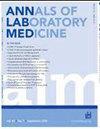Applying National Whole-genome Sequencing Findings for Rare Diseases in Clinical Practice: The Imperative of a Multidisciplinary Approach.
IF 3.9
2区 医学
Q1 MEDICAL LABORATORY TECHNOLOGY
引用次数: 0
Abstract
Background As nationwide government-led whole-genome sequencing (WGS) projects progress, optimizing the clinical integration of large-scale WGS results is crucial. We explored how the initial analysis from Korea's First WGS Pilot Study for Rare Diseases was applied in clinical practice, and then we reanalyzed the data comprehensively at Samsung Medical Center (SMC) Seoul, Korea. Methods A prospective cohort study designed to collect WGS data under a Korean national initiative was conducted from August 2020 to December 2021. We focused on patients with rare diseases recruited from 16 university hospitals. The participants included 5,000 individuals (2,200 probands and 2,800 family members). The initial WGS data and diagnostic reference reports (from 682 probands and 484 family members), generated based on the First Korean WGS Pilot Study for Rare Diseases, were subsequently reanalyzed by SMC. Results The initial analysis of the First Korean WGS Pilot Study data revealed a diagnostic rate of 17%. Upon receiving these results, the SMC conducted two rounds of reanalysis, increasing the diagnostic rate from 15% in the first analysis, to 18% in the second, and finally to 24% in the third (P =1.6×10-5). Key factors in improving the genetic diagnosis included increased detection of novel (likely) pathogenic variants (P =1.0×10-4), improved diagnostic rates with larger family recruitment (P =0.004), and refined clinical information for more precise genotype-phenotype correlation analysis (40%). Conclusions Although national WGS projects lay a foundation for rare disease diagnosis, hospital-level reanalysis and multidisciplinary collaborations are crucial for optimizing diagnostic outcomes.将国家全基因组测序结果应用于罕见病临床实践:多学科方法的必要性。
随着全国范围内政府主导的全基因组测序(WGS)项目的进展,优化大规模全基因组测序结果的临床整合至关重要。我们探讨了韩国首次罕见病WGS试点研究的初步分析如何应用于临床实践,然后我们在韩国首尔三星医疗中心(SMC)对数据进行了全面的重新分析。方法根据韩国国家倡议,于2020年8月至2021年12月进行了一项旨在收集WGS数据的前瞻性队列研究。我们的重点是从16所大学医院招募的罕见疾病患者。参与者包括5000人(2200名先证者和2800名家庭成员)。最初的WGS数据和诊断参考报告(来自682名先证者和484名家庭成员)是基于韩国首次罕见病WGS试点研究生成的,随后由SMC重新分析。结果首次韩国WGS试点研究数据的初步分析显示诊断率为17%。SMC收到这些结果后,进行了两轮再分析,将诊断率从第一次分析的15%提高到第二次分析的18%,最后提高到第三次分析的24% (P =1.6×10-5)。提高遗传诊断的关键因素包括增加了新的(可能的)致病变异的检出率(P =1.0×10-4),增加家族招募提高了诊断率(P =0.004),以及改进了临床信息以进行更精确的基因型-表型相关分析(40%)。结论虽然国家WGS项目为罕见病诊断奠定了基础,但医院层面的再分析和多学科合作对于优化诊断结果至关重要。
本文章由计算机程序翻译,如有差异,请以英文原文为准。
求助全文
约1分钟内获得全文
求助全文
来源期刊

Annals of Laboratory Medicine
MEDICAL LABORATORY TECHNOLOGY-
CiteScore
8.30
自引率
12.20%
发文量
100
审稿时长
6-12 weeks
期刊介绍:
Annals of Laboratory Medicine is the official journal of Korean Society for Laboratory Medicine. The journal title has been recently changed from the Korean Journal of Laboratory Medicine (ISSN, 1598-6535) from the January issue of 2012. The JCR 2017 Impact factor of Ann Lab Med was 1.916.
 求助内容:
求助内容: 应助结果提醒方式:
应助结果提醒方式:


